The single greatest flaw in the the Loch Lomond bye law consultation process, which I touched on in my last post (see here), concerns the lack of any background analysis and the selective presentation of information by Loch Lomond and Trossachs National Park Authority (LLTNPA) staff to justify their proposals. These are unlikely to address the issues the LLTNPA claims need to be addressed and have major implications for the rights of people who use the loch (which I will consider in a third post).
A disastrous failure in planning
In the summer, about the time the byelaw consultation was launched, the LLTNPA abandoned its draft Outdoor Recreation Plan (see here) which it had consulted on in December 2019. At the time Mary Jack pointed out that none of the plans for improving infrastructure for water recreation on Loch Lomond had been delivered and the new plan was devoid of any concrete proposals (see here). I made similar points about the vacuous nature of the draft plan soon a month later(see here):
“While the “plan” does acknowledge the need to improve infrastructure for watersports under the final theme of Coasts and Water – another box ticked in Scotland’s Year of Coasts and Waters 2020 – there is not a single concrete proposal. There is also no reference let alone analysis of why, in the last Outdoor Recreation Plan, the area where least progress was watersports infrastructure let alone the role that the LLTNPA played in cutting infrastructure in places like Milarrochy (see here).”
There was not a single reference to the Loch Lomond byelaws in that draft Outdoor Recreation Plan nor of any need for additional controls. Conversely, there is no mention in the LLTNPA’s Review Report to Scottish Ministers on the byelaws of what has happened to the Outdoor Recreation Plan or the history of failure to invest in infrastructure for watersports on the Loch. This is despite the Review Report clearly stating;
“While the byelaws are an important management tool, they are just one part of a combination of measures and approaches to managing behaviour and activities on the Loch.”
The Outdoor Recreation Plan was the place to set all of that out, without it there is no context to evaluate what is being proposed. Instead the LLTNPA claims in the Review Report they will do this in the new National Park Partnership Plan. We will see but this is a case of first introduce rule changes, then plan for it!
An illlustration of the failures of the current regime at the LLTNPA to plan, boat surveys had “been conducted on Loch Lomond since 1989 with yearly surveys until 2013, with a gap in time until 2022” when the LLTNPA commissioned a new survey. The abandonment of the survey after 2013 is not a coincidence, it’s when the LLTNPA switched their attention to campers. The new Boat Survey (see here) was completed AFTER the consultation process was completed, too late to provide consultees with the key facts.
The changing patterns of outdoor recreation on Loch Lomond – what is the truth?

The LLTNPA are right that there have been significant changes in the type of outdoor recreation taking place on the Loch over the last few years, the claim there has been a marked upturn in use of jet skis is bunkum. First, as the LLTNPA admits, the proportion of motorised vessels using the loch has dropped dramatically:
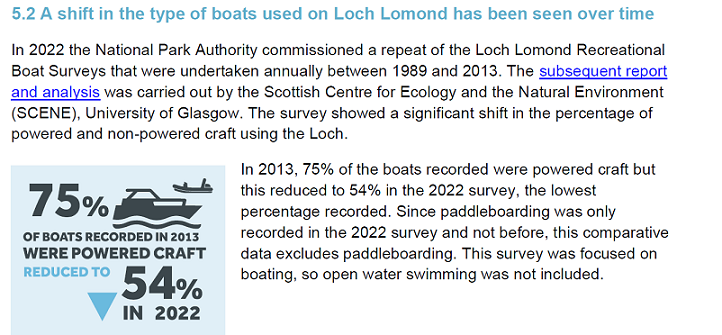
Note that throughout the Review Report the LLTNPA quotes percentages, not actual numbers, which obfuscates the truth about what is going on. There has not just been a shift in the percentage of powered craft but also a significant reduction in numbers as shown by figures collected by the Loch Lomond Association and previously published on parkswatch. These show a steady drop in all types of boats except for “other” between 2003 and 2015:

In the Review report, however, the LLTNPA claim that there was a 31% increase in jet skis between 2019 and 2022 and a 61% increase since 2012.
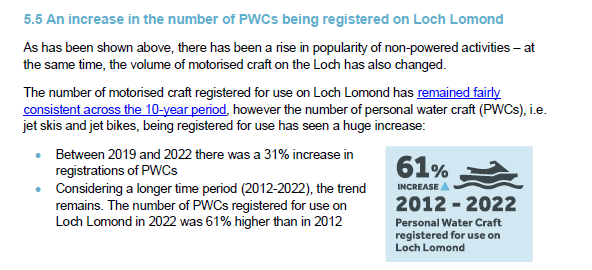
The LLA table above shows that 2012 was the LOWEST year for jet ski registrations ever recorded so by using that as the base year the LLTNPA have manipulated the figures to suggest any increase is far larger than it has been.
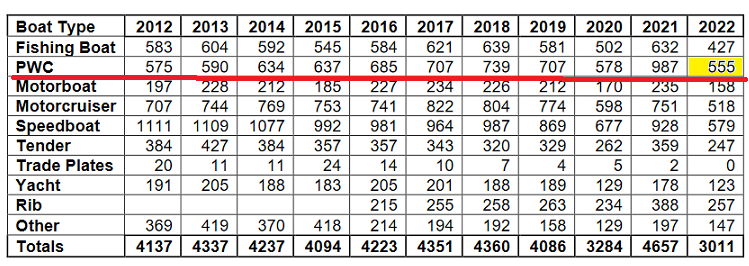 Far from there being a 31% increase in jet ski registrations between 2019 – 2022 there was a drop of c20% and 2022 was the lowest number recorded since before 2003 and perhaps ever!.
Far from there being a 31% increase in jet ski registrations between 2019 – 2022 there was a drop of c20% and 2022 was the lowest number recorded since before 2003 and perhaps ever!. 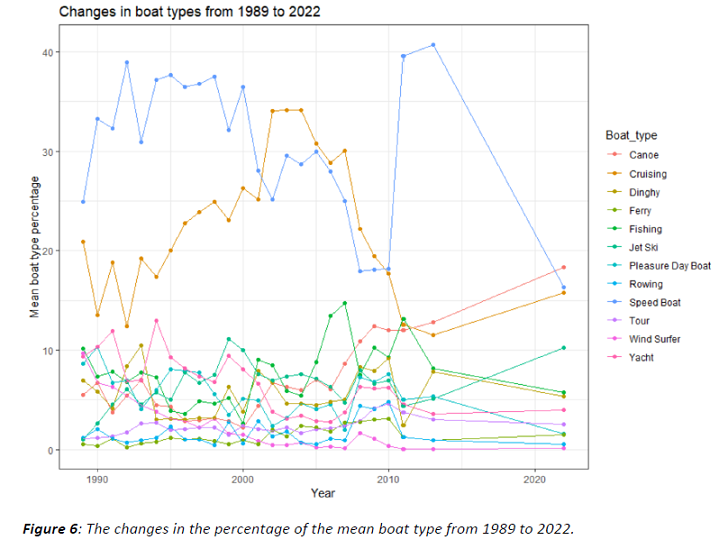
The graphics and data in the Loch Lomond Survey report are far more reliable. They show that the proportion of jet skis seen on the Loch has varied significantly from year to year and provide a warning against assuming changes in boat registrations from year to year can be used to make claims about long term trends. The fact is the number of jet skis are still less than the number of speed boats or cruisers, although their numbers have dropped dramatically. It is also worth noting the red line which shows canoes are now the most common boat on the Loch (apart from paddle boards which were not included in the graph).
The Survey also undertook a separate analysis of the most popular areas of the loch that included swimmers and paddleboards. This rather puts the number of jet skis in perspective.
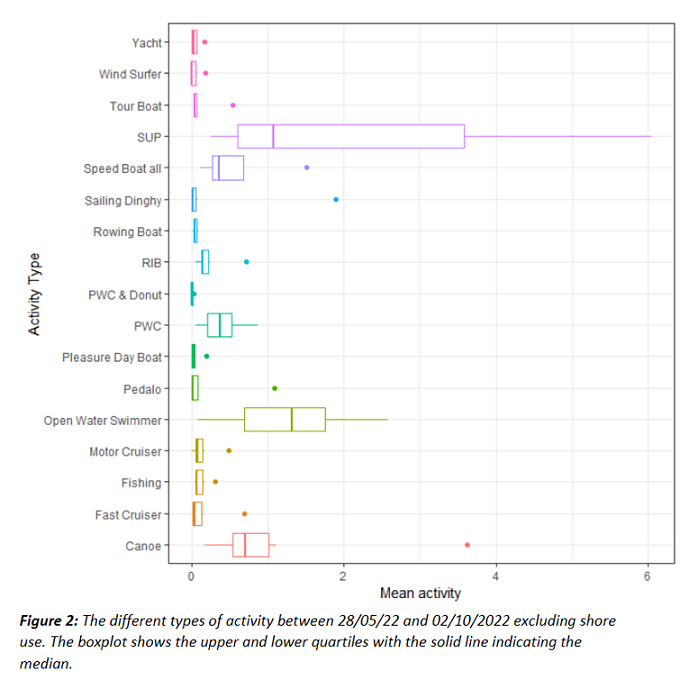
The LLTNPA’s claim in the Review Report that there has been a significant increase in the number of jet skis and that something needs to be done about this is completely wrong. If the report is not amended by the LLTNPA Board or rejected by Scottish Ministers any decision they make should be wide open to legal challenge.
The changes in numbers of jet ski registrations?
As the Review Report admits and everyone should know, the two years after the outbreak of the Covid pandemic were atypical because of the recreational bounce once lockdown was properly lifted. That accounts for the large number of registrations of all boat types in 2021 and the LLTNPA’s own data shows that the number of registrations for all types of vessel then dropped in 2022. Crisis, what crisis?
in the Review Report the LLTNPA also say nothing about the number of jet skis registered by individuals as opposed to businesses. Cameron House, for example, now appears to have a large flotilla of jet sksi and is one of several businesses around the Loch which now hire out a range watersports equipment. This has helped drive the huge increase in paddleboarding recorded in the recreation survey. But it also looks quite possible that, given the drop in real wages and their cost, that an increasing proportion of jet skis on the Loch are now owned by hire businesses not individuals.
That has important implications for what the LLTNPA should be doing to address irresponsible behaviour by jet skiers and other types of recreational user..
Is anti-social behaviour getting worse and if so why?
There is a long history of clashes between individual users of motorised and non-motorised vessels on the Loch – although the statistics show many people are involved in a range of activities – and interactions between paddle boarders and jet skis now appear to be at the centre of this. The recreational boating survey, which in my view is quite sound and tries to report facts, provides good evidence for this: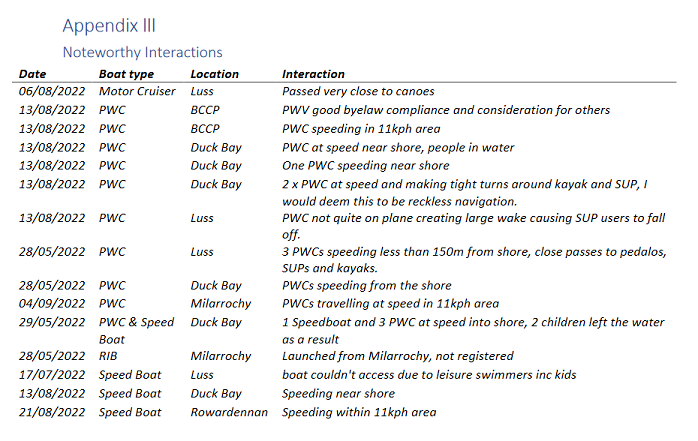 The problem, however, needs to be seen in perspective. LLTNPA cites two pieces of evidence in the Review Report to try and demonstrate an increase in antisocial behaviour.
The problem, however, needs to be seen in perspective. LLTNPA cites two pieces of evidence in the Review Report to try and demonstrate an increase in antisocial behaviour.
The first is that it claims the number of contraventions against the byelaws have increased 185% in ten years, with the sharpest increase being recently:
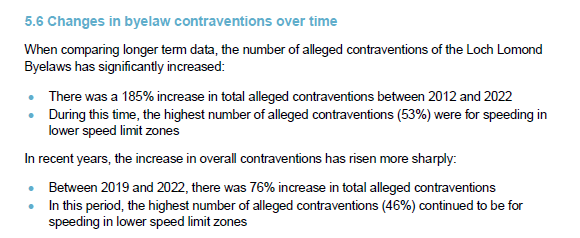
Again, these claims as presented as percentages, not actual figures. In another FOI response in July 2021 (see here), in which it was asked to provide data on byelaw violations/contraventions, the LLTNPA responded as follows:
“Records of violations are retained for three years, then deleted in accordance with our
record retention schedule. We therefore have to advise under section 17(1)(b) of the Act that
violation data for the years 2002 –2011 is not held.“
That appears untrue, the LLTNPA must hold some data to be able to claim contraventions have increased 185%! They still hold data for the last three years, but refused to release it:
“Violation data held for the last three years has been withheld from release under S34(1)(b)
of the Act as this information has been held for the purposes of an investigation, conducted
by the Park Authority, which may lead to the Authority deciding to make a report to the
Procurator Fiscal (PF) to decide whether criminal proceedings should be instituted.”
As an excuse for withholding information, this is utter nonsense. There have been hardly any referrals of anyone to the Procurator Fiscal for breach of byelaws. Luckily, someone who submitted a number of FOI managed to extract the following for the exceptional year of 2021 (see here):
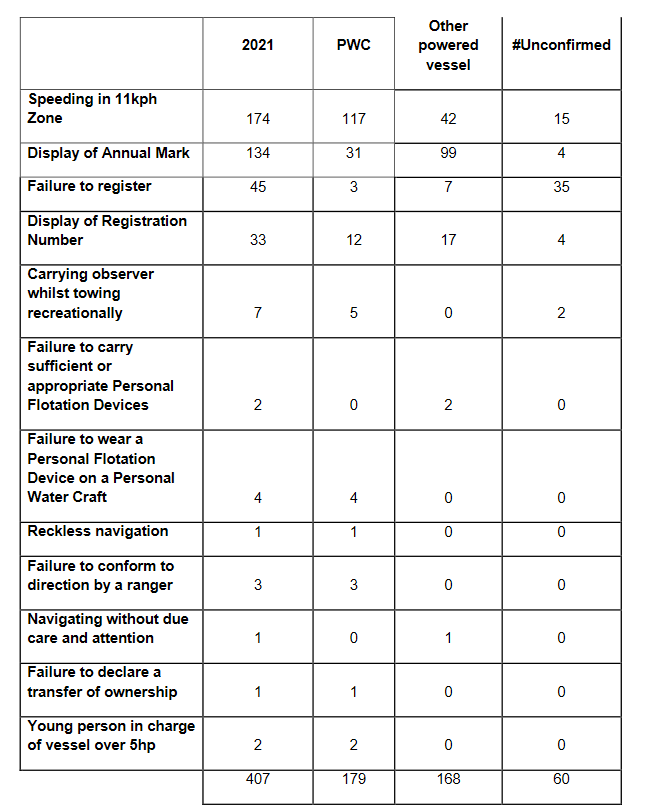
There are a couple of interesting conclusions that can be drawn from this data:
- First, the largest number of contraventions and over 50% of the total were linked to failures to observe the rules around registration (134 + 45 + 33 = 212) not antisocial behaviour. The LLTNPA has failed to explain this clearly.
- Second, by far the largest number of examples of antisocial behaviour concerned speeding and jet skis accounted for almost two thirds of this.
The second piece of evidence cited by the LLTNPA, supports the claim that jet skis are responsible for a high proportion of current complaints, but fails to show that problems are getting worse:
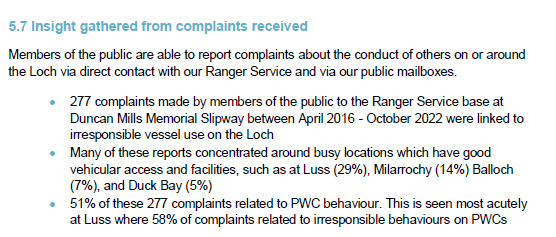
In the next para in the review report refers to “trends in complaints” but no data is provided to explain what these are. Para 5.7 certainly provides no insights into trends, rather it shows for the last six years on average about 45 complaints have been submitted to the Ranger Service at Duncan Mills slipway, about 23 of which on average are about jet skis.
The point here is that the LLTNPA has little or no data to substantiate that anti social behaviour by jet skiers is an increasing problem. That does not mean that there aren’t problems, only that the LLTNPA has failed to consider them in context and perspective.
So what are the problems and the solutions
One explanation for why some people think problems are getting worse is not that anti-social behaviour by jet skiers is increasing but rather more people are being affected because of the increase in numbers of swimmers and paddleboarders, the recreational groups most likely to be affected by power boats (e.g by their wash).
This is not a reason to demonise the power boating community and Loch Lomond should be large enough for both. One cause of the problem is that there are a limited number of launching points and places where – if you are on a jetski – you can stop off for lunch (it is easier for a cruiser which doesn’t need to come ashore and can just drop anchor). In other words, people with different interests are all being concentrated in the same places. Those problems came to a head in 2021 due to the explosion in numbers of people and vessels post-Covid.
It is important, however, not to exaggerate the problem which was looked at by the 2022 Boat Survey which recorded the number of people/boats in the most popular areas :
“Overall, the highest mean activity was 104.7 activities conducted per km2 [that is just over 1 per 100m square] whilst the lowestwas 0 activities per km2, the mean of the all the mean activities across all sites was 5.9 activities per km2 (sd=5.6). Luss had significantly more activity than any other sites with a mean of 17.7 activities per km2″
Unfortunately, instead of trying to engage with jet skiers to work out solutions about how they could co-exist with other activities, the LLTNPA’s response was to try and ban motorised vessels from the most popular areas on Loch without any consideration the impact this would have on them.
The LLTNPA have been forced to back down – for a time at least – by the threat of legal action under the right of navigation. As a consequence, the LLTNPA has come up with a much better solution, to reduce the speed limit in the most popular areas to 6 kph (while strangely doing nothing to reduce the maximum speed limit outside the 11kph zones which is 90 kph).
The challenge now is that while many people using motorised vessels, including jet skiers, will respect and otherwise pay consideration to other users of the Loch a minority won’t. Some of this may be out of ignorance, which is why the LLTNPA retaining control over businesses that hire out jet skis to ensure that those doing so are properly briefed and supervised is so important. But there are also deliberate mischief makers and people who pay little regard to others and to control their behaviour an effective ranger presence essential.
To provide such a presence rangers need to be dispersed around the Loch and on the ground, not based in an office at Balloch. This is far too far away to respond to issues at Luss, for example, the area where the greatest single number of problems occur. (This is another reason why the LLTNPA Board should never have agreed to put the Luss Visitor Centre on the market (see here)). Second the LLTNPA’s Rangers need the equipment to do the job. Incredibly, the LLTNPA don’t possess a single craft capable of catching power boat miscreants. Their lame excuse for this in the Review Report is that “The practicality of using PWC for patrolling purposes has also been considered but deemed challenging from staff welfare and enforcement perspectives”.
Had the LLTNPA concentrated on speed limits and having an effective ranger presence on the ground, there would have been little objection by the motorised boating community. It appears, however, the LLTNPA has another agenda which involves trying to get the Scottish Government to legislate to remove the historic right of navigation and to raise new income through a User Registration scheme which has serious implications for their rights I will consider that in my third post.
Source link
